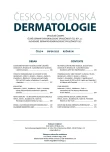Autoinflammatory Syndromes with Skin Manifestations
Authors:
P. Cetkovská 1; N. Benáková 2
Authors‘ workplace:
Dermatovenerologická klinika FN a LF UK v Plzni, přednosta prof. MUDr. Karel Pizinger, CSc.
1; Dermatovenerologická klinika 1. LF UK a VFN, Praha, přednosta prof. MUDr. Jiří Štork, CSc.
2
Published in:
Čes-slov Derm, 90, 2015, No. 4, p. 144-155
Category:
Reviews (Continuing Medical Education)
Overview
The autoinflammatory syndromes represent a newly classified heterogenous subset of familiar or sporadic diseases, that are characterized by seemingly unprovoked episodes of inflammation due to excessive interleukin-1β activation. They manifest mainly in childhood with skin lesions, recurrent attacks of fever and joint symptoms. Their immunopathogenic mechanisms are gradually being revealed due to increasing level of knowledge and it appears that even common dermatoses might have present autoinflammatory signs. Recognition of the pathogenetic role of inflammasomes and key mediators of innate immune system opens the possibility for new targeted therapies.
Key words:
autoinflammatory syndromes – inflammasome – interleukin 1 – periodic fevers – anti IL-1 biologics
Sources
1. AKSEKSENTIJEVICH, I., MASTERS, SL., FERGUSON, PJ., et al. An Autoinflammatory Disease with Deficiency of the Interleukin-1 – Receptor Antagonist. N. Engl. J. Med., 2009, 360, p. 2426–2437.
2. BENÁKOVÁ, N. Zpráva z 6. mezinárodního kongresu Psoriasis from gene to clinic. Čes- slov Derm, 2012, 87, 1, s. 27–28 .
3. BRAUN-FALCO, M., KOVNERYSTYY, O., LOHSE, P., RUZICKA, T. Pyoderma gangrenosum, acne, and suppurative hidradenitis (PASH) – a new inflammatory syndrome distinct from PAPA syndrome. J. Am. Acad. Dermatol., 2012, 66 (3), p. 409–415.
4. BUCHVALD, D. Monogénové autozápalové syndrómy v detskej dermatológii. Referátový výběr, 2014, 56, s. 12–20.
5. DÁVILLA-SEIJO, P., HERNÁNDEZ-MARTÍN, A., TORRELO, A. Autoinflammatory syndromes for the dermatologist. Clinics in Dermatology, 2014, doi: 10.1016/j.clindermatol.2014.02.004.
6. DAVIS, B. K., WEN, H., TING, J. P. I. The inflammasome NLRs in immunity, inflammation and associated diseases. An. Rev. Immunol., 2011, 29, p. 707–735.
7. CHRISTPHERS, E., METZLER, G., RöCKEN, M. Bimodal immune activation in psoriasis. Br. J. Dermatol., 2014, 170, 1, p. 59–65.
8. LINDOR, N. M., ARSENAULT, T. M., SOLOMON, H. et al. A new autosomal dominant disorder of pyogenic sterile arthritis, pyoderma gangrenosum, and acne: PAPA syndrome. Mayo Clin. Proc., 1997, 72 (7), p. 611–615.
9. McCOY, S. S., STANNARD, J., KAHLENBERG, J. M. Targeting the inflammasome in rheumatic diseases. Translational Research, 2015, DOI: http://dx.doi.org/10.1016/j.trsl.2015.06.006
10. McDERMOTT, A., JACKS, J., KESSLER, M. et al. Proteasome-associated autoinflammatory syndromes: advances in pathogeneses, clinical presentations, diagnosis and management. Int. J. Dermatol., 2015, 54, p. 121–129.
11. McDERMOTT, M. F., AKSENTIJEVICH, I., GALON, J. et al. Germline mutations in the extracellular domains of the 55 kDa TNF receptor, TNFR1, define a family of dominantly inherited autoinflammatory syndromes. Cell, 1999, 97, 1, p. 133–144.
12. MEIER, B., FRENCH, L. E. Autoinflammationssyndrome – kutanne Manifestationen. Dtsch. Med. Wochenschr., 2014, 139, p. 1468–1472.
13. NGUYEN, T. V., COWEN, E. W., LESLIE, K. S. Autoinflammation: From monogenic syndromes to common skin diseases. J. Am. Acad. Dermatol., 2013, 68 (5), p. 834–853. http://dx.doi.org/10.1016/j.jaad.2012.11.002.
14. PAVELKA, K., ARENBERGER, P., LUKÁŠ, M., ZIMA, T., DOLEŽAL, T., OLEJÁROVÁ, M., CETKOVSKÁ, P. et al.: Biologická léčba zánětlivých autoimunitních onemocnění. 1.vyd. Praha: Grada, 2014, 384 s.
15. SAVIC, S., DICKIE, L. J., WITTMANN, M., McDERMOTT, M. F. Autoinflammatory syndromes and cellular responses to stress: pathophysiology, diagnosis and new treatment perspectives. Best Practice and Research Clinical Rheumatology, 2012, 26, 4, p. 505–533. http://dx.doi.org/10.1016/j.berh.2012.07.009.
16. SHINAWI, M., SCAGLIA, F., WINDLE, M. L. Hereditary Periodic Fever Syndromes. http://emedicine.medscape.com/article/952254-overview, 2013, 31 p.
17. ZUBERBIER, T., ABERER, W., ASERO, R. et al. EAACI/GA(2)LEN/EDF guideline for the definition, classification, diagnosis and management of urticaria: the 2013 revision and update. Allergy, 2014, 7, p. 868–887.
Labels
Dermatology & STDs Paediatric dermatology & STDsArticle was published in
Czech-Slovak Dermatology

2015 Issue 4
Most read in this issue
- Autoinflammatory Syndromes with Skin Manifestations
- Coincidence of Five Primary Melanomas in One Patient
- Significance of Serum Levels of CRP, Lp-PLA2, Leptin and Lipocalin 2 in Patients with Psoriasis
